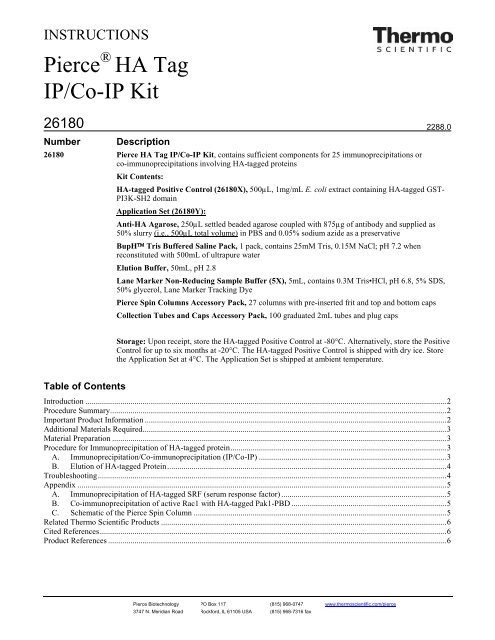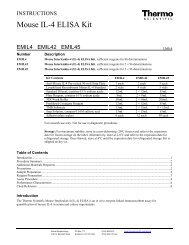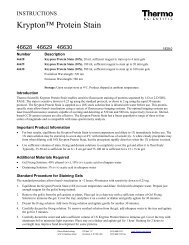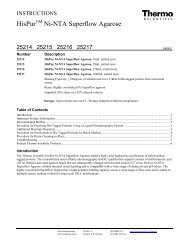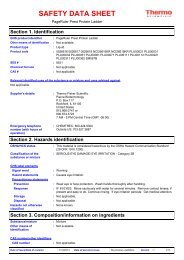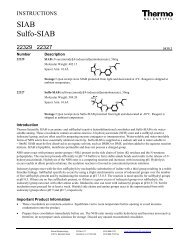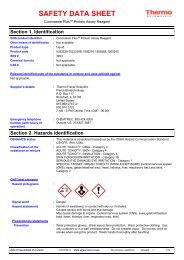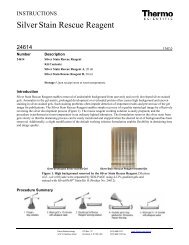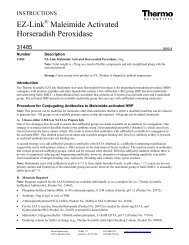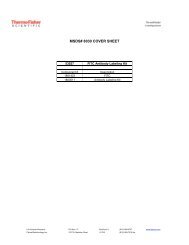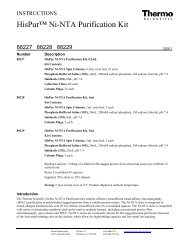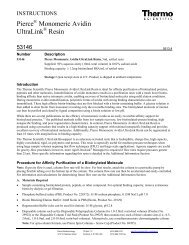Pierce HA Tag IP/Co-IP Kit
Pierce HA Tag IP/Co-IP Kit
Pierce HA Tag IP/Co-IP Kit
You also want an ePaper? Increase the reach of your titles
YUMPU automatically turns print PDFs into web optimized ePapers that Google loves.
INSTRUCTIONS<br />
<strong>Pierce</strong> ® <strong>HA</strong> <strong>Tag</strong><br />
<strong>IP</strong>/<strong>Co</strong>-<strong>IP</strong> <strong>Kit</strong><br />
26180<br />
Number<br />
Description<br />
26180 <strong>Pierce</strong> <strong>HA</strong> <strong>Tag</strong> <strong>IP</strong>/<strong>Co</strong>-<strong>IP</strong> <strong>Kit</strong>, contains sufficient components for 25 immunoprecipitations or<br />
co-immunoprecipitations involving <strong>HA</strong>-tagged proteins<br />
<strong>Kit</strong> <strong>Co</strong>ntents:<br />
<strong>HA</strong>-tagged Positive <strong>Co</strong>ntrol (26180X), 500µL, 1mg/mL E. coli extract containing <strong>HA</strong>-tagged GST-<br />
PI3K-SH2 domain<br />
Application Set (26180Y):<br />
Anti-<strong>HA</strong> Agarose, 250µL settled beaded agarose coupled with 875µg of antibody and supplied as<br />
50% slurry (i.e., 500µL total volume) in PBS and 0.05% sodium azide as a preservative<br />
BupH Tris Buffered Saline Pack, 1 pack, contains 25mM Tris, 0.15M NaCl; pH 7.2 when<br />
reconstituted with 500mL of ultrapure water<br />
Elution Buffer, 50mL, pH 2.8<br />
Lane Marker Non-Reducing Sample Buffer (5X), 5mL, contains 0.3M Tris•HCl, pH 6.8, 5% SDS,<br />
50% glycerol, Lane Marker Tracking Dye<br />
<strong>Pierce</strong> Spin <strong>Co</strong>lumns Accessory Pack, 27 columns with pre-inserted frit and top and bottom caps<br />
<strong>Co</strong>llection Tubes and Caps Accessory Pack, 100 graduated 2mL tubes and plug caps<br />
2288.0<br />
Storage: Upon receipt, store the <strong>HA</strong>-tagged Positive <strong>Co</strong>ntrol at -80°C. Alternatively, store the Positive<br />
<strong>Co</strong>ntrol for up to six months at -20°C. The <strong>HA</strong>-tagged Positive <strong>Co</strong>ntrol is shipped with dry ice. Store<br />
the Application Set at 4°C. The Application Set is shipped at ambient temperature.<br />
Table of <strong>Co</strong>ntents<br />
Introduction ................................................................................................................................................................................. 2<br />
Procedure Summary ..................................................................................................................................................................... 2<br />
Important Product Information .................................................................................................................................................... 2<br />
Additional Materials Required ..................................................................................................................................................... 3<br />
Material Preparation .................................................................................................................................................................... 3<br />
Procedure for Immunoprecipitation of <strong>HA</strong>-tagged protein .......................................................................................................... 3<br />
A. Immunoprecipitation/<strong>Co</strong>-immunoprecipitation (<strong>IP</strong>/<strong>Co</strong>-<strong>IP</strong>) ............................................................................................ 3<br />
B. Elution of <strong>HA</strong>-tagged Protein ......................................................................................................................................... 4<br />
Troubleshooting ........................................................................................................................................................................... 4<br />
Appendix ..................................................................................................................................................................................... 5<br />
A. Immunoprecipitation of <strong>HA</strong>-tagged SRF (serum response factor) ................................................................................. 5<br />
B. <strong>Co</strong>-immunoprecipitation of active Rac1 with <strong>HA</strong>-tagged Pak1-PBD ............................................................................ 5<br />
C. Schematic of the <strong>Pierce</strong> Spin <strong>Co</strong>lumn ............................................................................................................................ 5<br />
Related Thermo Scientific Products ............................................................................................................................................ 6<br />
Cited References .......................................................................................................................................................................... 6<br />
Product References ...................................................................................................................................................................... 6<br />
<strong>Pierce</strong> Biotechnology PO Box 117 (815) 968-0747 www.thermoscientific.com/pierce<br />
3747 N. Meridian Road Rockford, lL 61105 USA (815) 968-7316 fax
Introduction<br />
The Thermo Scientific <strong>Pierce</strong> <strong>HA</strong>-<strong>Tag</strong> <strong>IP</strong>/<strong>Co</strong>-<strong>IP</strong> <strong>Kit</strong> provides a simple and fast method to study <strong>HA</strong>-tagged proteins, with<br />
advantages over the traditional <strong>IP</strong> procedure using protein A/G agarose. The high affinity anti-<strong>HA</strong> antibody-coupled agarose<br />
enables immunoprecipitation (<strong>IP</strong>) of <strong>HA</strong>-tagged proteins or co-immunoprecipitation (co-<strong>IP</strong>) of their interacting partners<br />
without antibody contamination. The microcentrifuge spin columns provided with the kit handle small volumes of anti-<strong>HA</strong><br />
agarose and allow the entire procedure to be performed in a single spin column, preventing anti-<strong>HA</strong> agarose loss between<br />
washes. The spin columns further enhance recovery by efficiently separating buffer from the anti-<strong>HA</strong> agarose. 1<br />
Epitope tagging is a widely used method that enables surveillance of the resultant fusion protein with tag-specific rather than<br />
protein-specific antibodies. 2, 3 Immunoprecipitation of epitope-tagged proteins can be performed to determine the protein’s<br />
cellular localization, to study post-translational modifications or to detect interactions between tagged proteins and other<br />
proteins. A common epitope tag is the <strong>HA</strong> tag, which consists of nine amino acids (YPYDVPDYA) derived from the human<br />
influenza virus hemagglutinin (<strong>HA</strong>) protein. Immunoprecipitation of <strong>HA</strong>-tagged proteins using anti-<strong>HA</strong> antibodies<br />
distinguishes the expressed protein from the natively expressed protein population.<br />
The <strong>Pierce</strong> <strong>HA</strong>-<strong>Tag</strong> <strong>IP</strong>/<strong>Co</strong>-<strong>IP</strong> <strong>Kit</strong> uses a high-affinity anti-<strong>HA</strong> antibody that enables the isolation and identification of tagged<br />
protein regardless of its expression level. The covalent linkage between the antibody and the agarose results in a final<br />
immunoprecipitated product free of antibody contamination. The <strong>HA</strong>-tagged positive control can be used to verify <strong>IP</strong> and<br />
anti-<strong>HA</strong> agarose performance (see Appendix for example data).<br />
Procedure Summary<br />
1. Lyse cells expressing the target<br />
<strong>HA</strong>-tagged protein.<br />
2. <strong>Co</strong>mbine cell lysate and anti-<strong>HA</strong><br />
agarose beads in spin column.<br />
3. Incubate at 4°C for 1 hour to<br />
overnight with end-over-end mixing.<br />
<strong>Co</strong>llection Tube<br />
Bottom Plug<br />
Removed<br />
4. Pulse centrifuge 10 seconds. 5. Wash three times with TBS-T.<br />
Pulse centrifuge after each wash.<br />
6. Elute <strong>HA</strong>-tagged protein using<br />
Elution Buffer or Non-Reducing<br />
Sample Buffer.<br />
Important Product Information<br />
• For best results, determine optimal conditions for <strong>HA</strong>-tagged fusion protein expression before attempting <strong>IP</strong>.<br />
• Include a non-transfected lysate as a negative control to identify nonspecific binding of proteins to the anti-<strong>HA</strong> agarose.<br />
The <strong>HA</strong>-tagged Positive <strong>Co</strong>ntrol assists in verifying whether the anti-<strong>HA</strong> agarose can successfully capture the <strong>HA</strong>tagged<br />
protein.<br />
• The buffer provided in the kit allows complete flexibility to determine optimal conditions for isolating interacting<br />
proteins. Characteristics of interacting proteins may require alteration of the binding and wash buffers. Protein cofactors,<br />
divalent cations, detergents or additional salts may be added.<br />
• For optimal results in obtaining <strong>HA</strong>-tagged proteins, add protease inhibitors (e.g., Thermo Scientific Halt Protease<br />
Inhibitor Single-Use <strong>Co</strong>cktail, EDTA-Free, Product No. 78425) when preparing any lysate.<br />
<strong>Pierce</strong> Biotechnology PO Box 117 (815) 968-0747 www.thermoscientific.com/pierce<br />
3747 N. Meridian Road Rockford, lL 61105 USA (815) 968-7316 fax<br />
2
Additional Materials Required<br />
• Microcentrifuge capable of 16,000 × g<br />
• Protease inhibitors (e.g., Product No. 78425 or 78430)<br />
• Tween ® -20 Detergent (Product No. 28320)<br />
• End-over-end rocker or rotator<br />
• Heat block<br />
• 0.2µm, 500mL filter apparatus<br />
• 1M Tris, pH 9.5<br />
• 1M DTT (Product No. 20291) or β-mercaptoethanol (Product No. 35602)<br />
Material Preparation<br />
• Tris-buffered saline (TBS): Reconstitute contents of the TBS pack with 500mL of ultrapure water. Filter sterilize<br />
solution using a 0.2µm filter apparatus and store at 4°C. Final concentration is 25mM Tris•HCl, 0.15M NaCl; pH 7.2.<br />
• Non-Reducing Sample Buffer (2X): Equilibrate the Non-Reducing Sample Buffer (5X) to room temperature. Gently<br />
mix the Sample Buffer by inverting the bottle 5-10 times. The Sample Buffer is viscous and may require that the pipette<br />
tip be “snipped” to allow the solution to be drawn into the tip. Dilute Sample Buffer by adding 600µL ultrapure water to<br />
400µL Sample Buffer. Pipette up and down to mix. Store this solution at 4°C for up to 1 year.<br />
Procedure for <strong>IP</strong>/<strong>Co</strong>-<strong>IP</strong> of <strong>HA</strong>-tagged Protein<br />
A. <strong>IP</strong>/<strong>Co</strong>-<strong>IP</strong><br />
Note: The amount of lysate needed and incubation time are dependent upon the expression level of the <strong>HA</strong>-tagged protein<br />
and requires optimization for each specific system. For co-<strong>IP</strong> experiments, the buffer system must be optimized to maintain<br />
the protein:protein interaction.<br />
1. Place the bottom plugs on the spin columns and ensure that the inserted porous disc in each column is seated properly at<br />
the bottom. Add the appropriate amount of lysate to the spin columns.<br />
Note: For initial optimization, use 200µL lysate (400-600µg total protein) from a 60mm plate of confluent cells (see<br />
Figure 1). Maximum volume for the spin column is 850µL.<br />
2. To set up a positive control, use 50µL of the <strong>HA</strong>-tagged Positive <strong>Co</strong>ntrol diluted in 150µL TBS.<br />
3. Thoroughly resuspend the anti-<strong>HA</strong> agarose by inverting the vial several times immediately before dispensing. Do not<br />
vortex. Dispense 20µL of anti-<strong>HA</strong> agarose slurry (= 35µg of antibody) into each labeled spin column using a wide-bore<br />
pipette tip. Screw on the cap.<br />
4. Incubate with gentle end-over-end mixing for at least 1 hour at 4ºC; typical incubation times range from 2 hours to<br />
overnight.<br />
5. Prepare a wash solution of TBS plus 0.05% Tween-20 (TBS-T) Detergent. For each spin column, prepare approximately<br />
3mL of wash solution.<br />
6. Loosen the top cap on the column, and then remove the bottom plug. Place a collection tube under the column and pulse<br />
centrifuge for 10 seconds. Discard the flow-through or save for future analysis.<br />
7. Add 0.5mL of TBS-T to each column. Loosely screw on the cap and gently invert the column with the collection tube<br />
2-3 times. Pulse centrifuge for 10 seconds. Discard the wash or save for future analysis.<br />
8. Repeat step 7 two additional times.<br />
<strong>Pierce</strong> Biotechnology PO Box 117 (815) 968-0747 www.thermoscientific.com/pierce<br />
3747 N. Meridian Road Rockford, lL 61105 USA (815) 968-7316 fax<br />
3
B. Elution of <strong>HA</strong>-tagged Protein<br />
Note: If the eluted <strong>HA</strong>-tagged protein will be used for functional applications, use Elution Protocol 1 to elute the protein. If<br />
the protein is sensitive to the low pH, use the Gentle Elution Buffer (Product No. 21027). For electrophoretic analysis, use<br />
Elution Protocol 2.<br />
• Elution Protocol 1:<br />
1. Place the spin column in a new collection tube. Add 10µL of Elution Buffer to the anti-<strong>HA</strong> agarose, loosely screw<br />
on the cap and gently tap the tube to mix. Pulse centrifuge for 10 seconds.<br />
Note: It is not necessary to place the bottom plug on the spin column for this step.<br />
2. Repeat step 1 two additional times. The three elutions may be recovered and pooled in one collection tube.<br />
Note: Neutralize the eluent immediately by adding 1µL of 1M Tris, pH 9.5 per 20µL of Elution Buffer.<br />
3. For reducing gel analysis, prepare reducing sample buffer by adding 10µL of 1M DTT or 5µL of β-ME to the 40µL<br />
of Lane Marker Non-Reducing Sample Buffer (5X).<br />
4. Add 7.5µL of the prepared reducing sample buffer to 30µL elution sample. Heat sample at 95-100°C for 5 minutes.<br />
• Elution Protocol 2:<br />
1. Place the spin column in a new collection tube. Add 25µL of 2X Non-Reducing Sample Buffer (see Material<br />
Preparation Section) to the anti-<strong>HA</strong> agarose, loosely screw on the cap and gently tap the tube to mix.<br />
Note: It is not necessary to place the bottom plug on the spin column for this step.<br />
2. Heat the spin column/tube assembly at 95-100°C on a heat block for 5 minutes. Pulse centrifuge for 10 seconds.<br />
Note: Using Non-Reducing Sample Buffer can minimize interference from co-eluting antibody fragments.<br />
3. To prepare the sample for reducing SDS-PAGE, add 2-3µL of 1M DTT or 1-2µL of β-ME to the 25µL sample.<br />
Note: The eluted <strong>HA</strong>-tagged Positive <strong>Co</strong>ntrol can be detected by coomassie or silver staining (see Related Thermo<br />
Scientific Products). For more sensitive detection methods such as Western blotting, dilute the eluted <strong>HA</strong>-tagged<br />
positive control 10- to 50-fold (0.2-0.5µL elution is usually sufficient for analysis).<br />
Troubleshooting<br />
Problem Cause Solution<br />
Little or no <strong>HA</strong>tagged<br />
protein is<br />
detected<br />
Failure to <strong>Co</strong>-<strong>IP</strong><br />
interacting<br />
protein<br />
<strong>Tag</strong>ged protein degraded<br />
No or minimal tagged protein was<br />
expressed<br />
Wash conditions were too stringent<br />
for the weak or transient interaction<br />
Interacting protein was expressed at a<br />
low level<br />
The buffer system was not optimal for<br />
the protein:protein interaction<br />
Include protease inhibitors (e.g., Product No. 78425 or<br />
78430) in the lysis buffer<br />
Use new lysate or lysate stored at -80°C<br />
Verify protein expression by SDS-PAGE or Western blot<br />
analysis of the lysate using <strong>HA</strong>-tagged Positive <strong>Co</strong>ntrol as a<br />
reference<br />
Increase the amount of lysate used for <strong>IP</strong>/<strong>Co</strong>-<strong>IP</strong><br />
Use a more sensitive detection system such as Thermo<br />
Scientific SuperSignal West Femto Chemiluminescent<br />
Substrate (Product No. 34095)<br />
Reduce the number of washes and/or lower the ionic strength<br />
of wash buffer<br />
Apply additional protein sample or use a more sensitive<br />
detection system<br />
Optimize the <strong>Co</strong>-<strong>IP</strong> buffer<br />
<strong>Pierce</strong> Biotechnology PO Box 117 (815) 968-0747 www.thermoscientific.com/pierce<br />
3747 N. Meridian Road Rockford, lL 61105 USA (815) 968-7316 fax<br />
4
Appendix<br />
A. Immunoprecipitation of <strong>HA</strong>-tagged SRF (serum response factor)<br />
10 25 50 100 200 400 600 800 µL lysate<br />
Figure 1. Immunoprecipitation of <strong>HA</strong>-tagged SRF (serum response factor) from a cell lysate. Human<br />
embryonic kidney cells (293) were transfected with pCMV-<strong>HA</strong>-SRF for 40 hours. Cells were lysed in<br />
Thermo Scientific M-PER Protein Extraction Reagent (200µL/60mm plate) containing protease inhibitors.<br />
Various amounts of lysate were incubated with 6µL anti-<strong>HA</strong> agarose slurry at 4°C overnight. <strong>HA</strong>-SRF was<br />
eluted with 25µL non-reducing sample buffer, and 10µL of the eluted <strong>HA</strong>-SRF was separated by SDS-<br />
PAGE, transferred to a nitrocellulose membrane and probed with anti-<strong>HA</strong> antibody. <strong>Pierce</strong> Goat Anti-Mouse<br />
IgG (H+L), Peroxidase <strong>Co</strong>njugated (Product No. 31430; 1:100,000 dilution) was used as the secondary<br />
antibody. The membrane was incubated with SuperSignal ® West Pico Chemiluminescent Substrate (Product<br />
No. 34080) and exposed to X-ray film.<br />
B. <strong>Co</strong>-immunoprecipitation of active Rac1 with <strong>HA</strong>-tagged Pak1-PBD<br />
Small GTPase Rac1 cycles between active GTP-bound form and inactive GDP-bound form. Upon activation, Rac1<br />
activates p21-activated protein kinase 1 (Pak1) through binding to the p21-binding domain (PBD) of Pak1. When Rac1<br />
mutant (Q61L) is co-expressed with <strong>HA</strong>-tagged Pak1-PBD, it is co-immunoprecipitated with <strong>HA</strong>-tagged Pak1-PBD<br />
using anti-<strong>HA</strong> agarose.<br />
1 2 3 4 1 2 3 4<br />
Rac1<br />
GST-<strong>HA</strong><br />
<strong>HA</strong>-Pak1-PBD<br />
Anti-Rac1<br />
Anti-<strong>HA</strong><br />
Figure 2. <strong>Co</strong>-<strong>IP</strong> of active Rac1 with <strong>HA</strong>-tagged Pak1-PBD (p21 binding domain). Human 293 cells were<br />
transfected with <strong>HA</strong>-Pak1-PBD alone or co-transfected with constitutively activated Rac1 (Q61L) in 293 cells. Cells<br />
were lysed in the buffer containing 25mM Tris, pH 7.2, 150mM NaCl, 5mM MgCl 2 , 0.5% NP-40, 1mM DTT, 5%<br />
glycerol and protease inhibitors (500µL/100mm plate). Anti-<strong>HA</strong> agarose slurry (6µL) was incubated with 50µL<br />
positive control lysate from the kit (Lane 1) or 500µL cell lysate from Rac1 (Q61L) and <strong>HA</strong>-Pak1-PBD co-transfected<br />
cells (Lane 2), <strong>HA</strong>-Pak1-PBD transfected cells (Lane 3) or non-transfected cells (Lane 4). <strong>IP</strong> and co-<strong>IP</strong> reactions were<br />
performed at 4°C overnight. <strong>IP</strong> and <strong>Co</strong>-<strong>IP</strong> products were eluted with 25µL nonreducing sample buffer. The Western<br />
blot was first probed with anti-Rac1 antibody and then reprobed with anti-<strong>HA</strong> antibody. <strong>HA</strong>-tagged GST and Pak1-<br />
PBD were immunoprecipitated by anti-<strong>HA</strong> antibody (right panel, lane 1-3), and active Rac1 was coimmunoprecipitated<br />
with <strong>HA</strong>-Pak1-PBD (left panel, lane 2).<br />
C. Schematic of the <strong>Pierce</strong> Spin <strong>Co</strong>lumn<br />
<strong>Pierce</strong> Biotechnology PO Box 117 (815) 968-0747 www.thermoscientific.com/pierce<br />
3747 N. Meridian Road Rockford, lL 61105 USA (815) 968-7316 fax<br />
5
Related Thermo Scientific Products<br />
26180X <strong>HA</strong>-<strong>Tag</strong>ged Positive <strong>Co</strong>ntrol, 500µL<br />
26181-2 Immobilized Anti-<strong>HA</strong> agarose, 1mL, 5mL resin<br />
26183 Anti-<strong>HA</strong> Antibody, 100µg<br />
26184 <strong>HA</strong> Peptide, 5mg<br />
78430 Halt Protease Inhibitor Single-Use <strong>Co</strong>cktail, 100µL × 24 microtubes<br />
78425 Halt Protease Inhibitor Single-Use <strong>Co</strong>cktail, EDTA-Free, 100µL × 24 microtubes<br />
24594 Gel<strong>Co</strong>de ® Blue Safe Protein Stain, colloidal coomassie protein stain for SDS-PAGE, 1L<br />
24615 Imperial Protein Stain, coomassie protein stain for SDS-PAGE, 1L<br />
24612 <strong>Pierce</strong> Silver Stain, silver stain for SDS-PAGE, kit for 20 mini-gels<br />
34080 SuperSignal West Pico Chemiluminescent Substrate for HRP, 500mL<br />
34095 SuperSignal West Femto Chemiluminescent Substrate for HRP, 100mL<br />
69705 <strong>Pierce</strong> Spin <strong>Co</strong>lumns and Accessories, 25 units (see website for listing of all spin column varieties)<br />
21027 Gentle Ag/Ab Elution Buffer, 500mL, pH 6.6<br />
35602 β-mercaptoethanol, 10 × 1mL<br />
20291 DTT (Dithiothreitol), No-Weigh Format, 7.7mg × 48 microtubes<br />
Cited References<br />
1. Brymora, A., et al. (2001). Enhanced protein recovery and reproducibility from pull-down assays and immunoprecipitations using spin columns. Anal<br />
Biochem 295:119-22.<br />
2. Kolodziej, P.A. and Young, R.A. (1991). Epitope tagging and protein surveillance. Methods Enzymol 194:508-19.<br />
3. Chen, Y.T., et al. (1993). Expression and localization of two low molecular weight GTP-binding proteins, Rab 8 and Rab 10, by epitope tag. Proc Natl<br />
Acad Sci 90:6508-12.<br />
Product References<br />
Itani, O., et al. (2005). Nedd4-2 isoforms differentially associate with Enac and regulate its activity. Amer J Physiol Renal 289:F334-46.<br />
Rathmell, W., et al. (2004). In vitro and in vivo models analyzing von Hippel-Lindau disease-specific mutations. Cancer Res 64:8595-603.<br />
Sakai, D., et al. (2006). <strong>Co</strong>operative action of Sox9, Snail2 and PKA signaling in early neural crest development. Development 133:1323-33.<br />
Viriyakosol, S., et al. (2006). Mutational analysis of membrane and soluble forms of human MD-2. J Biol Chem 281:11955-64.<br />
Wang, X., et al. (2006). The viral E3 ubiquitin ligase mK3 uses the Derlin/p97 endoplasmic reticulum-associated degradation pathway to mediate downregulation<br />
of major histocompatibility complex class I proteins. J Biol Chem 281:8636-44.<br />
Tween ® is a trademark of ICI Americas.<br />
This product (“Product”) is warranted to operate or perform substantially in conformance with published Product specifications in effect at the time of sale,<br />
as set forth in the Product documentation, specifications and/or accompanying package inserts (“Documentation”) and to be free from defects in material and<br />
workmanship. Unless otherwise expressly authorized in writing, Products are supplied for research use only. No claim of suitability for use in applications<br />
regulated by FDA is made. The warranty provided herein is valid only when used by properly trained individuals. Unless otherwise stated in the<br />
Documentation, this warranty is limited to one year from date of shipment when the Product is subjected to normal, proper and intended usage. This<br />
warranty does not extend to anyone other than the original purchaser of the Product (“Buyer”).<br />
No other warranties, express or implied, are granted, including without limitation, implied warranties of merchantability, fitness for any particular<br />
purpose, or non infringement. Buyer’s exclusive remedy for non-conforming Products during the warranty period is limited to replacement of or<br />
refund for the non-conforming Product(s).<br />
There is no obligation to replace Products as the result of (i) accident, disaster or event of force majeure, (ii) misuse, fault or negligence of or by Buyer, (iii)<br />
use of the Products in a manner for which they were not designed, or (iv) improper storage and handling of the Products.<br />
Current product instructions are available at www.thermoscientific.com/pierce. For a faxed copy, call 800-874-3723 or contact your local distributor.<br />
© 2011 Thermo Fisher Scientific Inc. All rights reserved. Unless otherwise indicated, all trademarks are property of Thermo Fisher Scientific Inc. and its<br />
subsidiaries. Printed in the USA.<br />
<strong>Pierce</strong> Biotechnology PO Box 117 (815) 968-0747 www.thermoscientific.com/pierce<br />
3747 N. Meridian Road Rockford, lL 61105 USA (815) 968-7316 fax<br />
6


